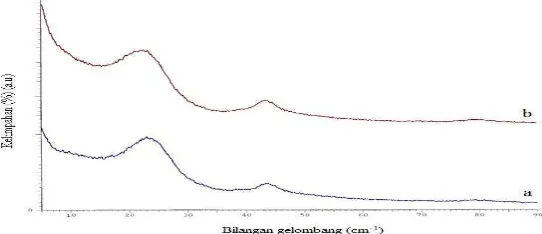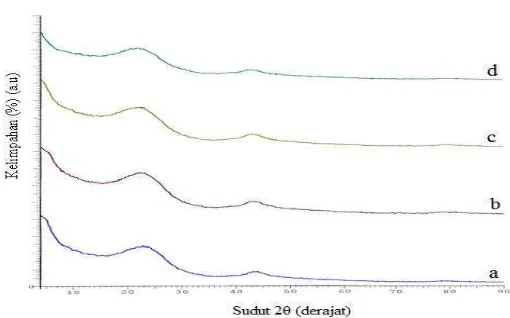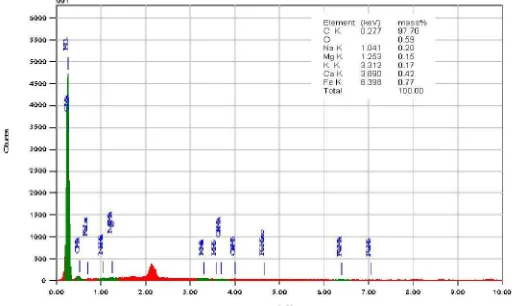C-31
STUDY ON GROWTH OF CARBON CRYSTAL FROM CHARCHOAL OBTAINED BY PYROLYSIS OF COCONUT SHELL
Meytij Jeanne Rampe1, Bambang Setiaji2, Wega Trisunaryanti2, Triyono2
1Department of Chemistry, Faculty of Mathematics and Natural Sciences, Manado State
University
2Department of Chemistry, Faculty of Mathematics and Natural Sciences, Universitas Gadjah
Mada.
E-mail: meytij_rampe@yahoo.co.id
Abstract
Study on the growth of carbon crystal produced from coconut shell has been conducted. This research was aimed to study the effects of PVA as stimulant agent in the from of either powder or solution on structural growth of carbon crystal and its physic-chemical properties and the effect of temperature (1000-1500 oC) on the characters of the
carbon. Several methods of characteristics were performed including FTIR to determine the functional groups of the carbon, XRD to identify the structure of carbon crystal, SEM-EDS to analyze the topography of surface and to analyze the component of material. The product characteristics of carbon material showed that there was a change on the physic-chemical properties of the raw material which has been sintered at 1000 oC,
at which coke was produced in this process. Fabrication process at 1500 oC in the
presence of PVA gave carbon material from charcoal amorphous to carbon with semi-crystalline structure.
Keywords: coconut shell charcoal, growth, carbon ctystal.
INTRODUCTION
The structure of chemical bonds that is formed contributes to the establishment of superior properties of carbon materials (Rampe et al., 2011; Buchman and Bryant, 1999). Carbon contains allotrope which has different types of chemical bonding structure, including graphite, diamond, black carbon, fullerence, carbon nano tubes (CNT). Graphite is a type of carbon material obtained from carbon atoms with sp2 orbital. One of these atoms forms a new bond with 3 carbon atoms. The microscopic material consists of graphite flat sheets from carbon atoms which are bonded, as the grapheme. The characteristics of the bond structure and dynamic interactions between the grapheme layers produce strong electrical conductivity properties (Buchman and Byant, 2002) which functions as a lubricant.
1000 – 1300 C, while graphite is a type of carbon which can be heated at temperatures higher than 2500 oC. Heating at higher temperature of 3000 oC will produce carbon that has an irregular structure which evolves to a more ordered graphite structure by removing the impurities of volatile material (Rampe, et al., 2012; Rampe et al., 2011; Elsayed et al., 2007).
This study used coconut shell charcoal as raw material which function as carbon to examine the growth of crystal in the development carbon composite. To obtain carbon from coconut shell charcoal, tar impurities and volatile material are removed. The removal of impurities is conducted by high temperature heating up to 600 – 1000 oC. This heating is also aimed to eliminate the compounds carried by the drainage of gas. During the heating process, all non-carbon materials must be removed to form a pure non-carbon as well as to arrange the structure (Wiratmoko and Halloran, 2009; Ebner et al., 2004). The removal of metals cam be carried out by soaking the carbon in a solution of HCl (( Fraga et al., 2002).
Heating process of coconut shell will produce a gradual change. In the first stages of the carbonization, the carbon samples become coke. The second stage is graphitization, in which coke is changed into graphite carbon whose irregular structures tend to grow (over the graphite whose structure is irregular) (Gupta et al., 2005; Miyazaki et al., 2005). The nature of carbon depends on its source (Kang et al., 2007), and on the method and conditions of synthesis (Lalena et al., 2008). The nature of carbon materials gives impact on their various uses, primarily as carbon electrodes and carbon material structure.
This study discusses the use of, coconut shell and polyvinyl alcohol (PVA) to produce carbon structure materials. The main purpose of this research is to study the crystal structure and chemical composition by using parameters such as concentration of polyvinyl alcohol and sintering temperature.
RESEARCH METHOD A. Materials
This study used coconut charchoals as the raw material produced by PT. Tropica Nucifera Industry Bantul Yogyakarta, Indonesia. This charchoal is the source of carbon and polyvinyl alcohol. Further, Merck stimulant and argon gas were used as inert atmosphere to get air free.
Calcination was conducted using a tube-Thermolyne Furnace (Sybron) Type 21100 with a maximum temperature of 1200 oC. Calcinated charcoal as raw material was obtained through 100 mesh grinding and sifting. For carbon materials, Tarno compacted Grocki 312 model a maximum of 20 tons was used. Sintering was carried out by using a Carbolite furnace-Edwards Pirani 501 A6D 1600 oC maximum temperature with argon gas as the atmosphere, Scanning Electron Microscopy (SEM) JOEL JSM-6360 LA and Energy Dispersive Spectroscopy (EDS) System JOEL JED-2300 was used while the Goniometer model difractometer with Cu Kα (α = 1.54056 Å) radiation was used for X-ray Diffraction (XRD) analysis.
B. Methods
1. Preparation and Charcoal Calcination
Carbon powder 100 mesh sieves was calcined in an inert state though two stages. First, was the calcinations at temperatures of 600 oC for 3 hours with the existence of nitrogen gas then followed by the purification of charcoal powder which was extracted for 24 hours with 1 M hydrochloric acid at room temperature (Gupta et al., 2005). The sample was washed with distilled water until it reached constant pH and was dried in an oven at temperatures of 110 oC overnight (Fraga et al., 2002). Re-calcination was carried out for 3 hours at temperature of 750 oC with nitrogen.
in distilled water at 353 K and stirred for one hour. Binder system was mixed with charcoal powder, forming a paste with the density in different systems. The next step was molding by using a cylindrical mold with a diameter of ~ 15 mm. Compaction was performed with one direction force by the means of Tarno Grocki with the thrust of 5 tons. In this stage, the process produced a sample of pellets (green compact). The samples were then dried at room temperature for one day before oven drying for 4 hours at 110 oC. The samples were then fed into a carbollite furnace for sintering at the temperature of 1000 oC. The rate of temperature was 10 K/min and reaction time was 3 hours. Then, these samples were cooled in the furnace at a rate of 8 K/min, with a flow of argon gas. This process produced dense coconut shell coke or carbon-carbon composite materials (Wiratmoko and Halloran, 2009; Miyazaki et al., 2005; Mothe and de Miranda, 2009).
3. Synthesis of carbon structures
The coke sample was heated for the 2nd time by sintering at 1200 oC, 1500 oC with a flow rate of 10 K/min, holding time of 3 hours, in the furnace Carbolite, with the furnace cooling rate of 8 K/min, under argon gas flow (Mendez and Santamaria, 2008).
RESULT AND DISCUSSION XRD analysis
[image:3.612.153.424.511.628.2]Figure 1 and 2 showed a typical X-ray diffraction (XRD) patent of testing charcoal, calcined carbon and coke carbon material that sintered at temperatures 1200 and 1500 oC. XRD diffractogram of charcoal, calcined carbon and coke carbon material gave value of interlayer spacing (d) (Å) as a graphite semi-crystalline structure. Yin et al. (2009) reported that the decrease of the (d) and the increase of the crystalline diameter and average stacking height of the aromatic carbon sheets (Lc) with increasing the temperature suggested the development of stacking structure, increased the size of crystallite as well as removal of defects and increased order in carbon material structure. The increase of Lc with increasing temperature resulted from crystalline growth in-plane and coalescence of crystallites. In this process, the structure of amorphous carbon structure was changed into semi-crystalline structure with a better degree of order, namely turbostatic structure (Rampe et al., 2010; Rampe et al., 2011). There was the change of internal structure by setting the position of equilibrium carbon atoms.
Figure 2. XRD pattern of carbon sintered 1500 : (a) coconut shell charcoal, (b) 2,5% wt. PVA, (c) 5 % wt. PVA, and (d) 7,5 % wt.PVA.
SEM-EDS analysis
Figure 3 and 4 showed the SEM photographs of carbon composite (C/PVA) sintered at 1500 oC, respectively. Figure 3 showed that coconut shell carbon was non-homogeneous particles distribution. Figure 4 showed a homogeneous and even surface morphology. The carbon structure from coconut shell cabon sintered at temperature of 1500 oC exhibited uniform particle size of micrometer dimensions and spherical particles shape (Lin and Yen, 2007). It was also shown in Figure 4 that the morphological features of carbon particles appeared to be more irregular, characteristics as a typical of carbon particles (Inagaki, 2000).
EDS analysis for carbon structure sintered at 1500 oC were shown in Figure 5,6 and 7, respectively. It was apparent that chemistry composition of carbon structure, carbon/PVA (2.5 and 5% wt.) (Figure 5 and 6) consisted of C element 97.16% wt. and C element was 97.35% wt. The carbon structure, carbon/PVA (7.5% wt.) (Figure 7) consisted of higher C element up to 97.70% wt. with average of C element was 97.40% wt.
[image:4.612.109.490.490.666.2]Heat treatment ranging from 1000 to 1500 oC, as demonstrated in this study, caused the aromatic layers grow and coalesce each other (Inagaki, 2000). This is due to the evolution of volatile matter (Rampe et al., 2011) and the breakage of cross-linking bonds such as CH2 bridge.
Figure 3. SEM micrographs of coconut shell carbon (5% wt. PVA) sintered 1500 oC
Figure 5. EDS analysis of the coconut shell carbon (2.5 % wt. PVA) sintered at 1500 oC.
Figure 6. EDS analysis of the coconut shell carbon (5 % wt. PVA) sintered at 1500 oC.
Figure 7. EDS analysis of the coconut shell carbon (7.5 % wt. PVA) sintered at 1500 oC.
CONCLUSION AND SUGGESTION
[image:5.612.109.366.455.608.2]1500 C in the presence of PVA gave carbon material from charcoal amorphous to carbon with semi-crystalline structure.
REFERENCES
Buchman, A dan Bryant, R.G., 1999, Molded Carbon-Carbon Composite Based on Microcomposite Technology, App. Comp. Mat., 6, 309-326.
Ebner, F., Hofer, C dan Maurer, E.M., 2004, Conversion of Carbonaceous Material to Graphite Within the Grey Wache Zone of the Eastern Alps, Int.J.Earth Sci (Geo Rundsch), 93, 959-973.
Elsayed, M.A., Hall, P.J. dan Heslop, M.J., 2007, Preparation and Structure Characterization of Carbon Prepared from Resorcinol-Formaldehyde Resin by CO2 Activation, Adsorption, 13, 299-306.
Fernandez, M.D., dan Fernandez, M.J., 2008, Thermal Degradation of Copolymers from Vinyl Acetate and Vinyl Alcohol, J.Therm.Anal.Calorim., 92, 829-837.
Fraga, M.A., Jordao, E., Mendes, M.J., Freitas, M.M.A., Faria, J.L., dan Figueredo, J.L.., 2002, Properties of Carbon-Supported Platinum Catalysts: Role of Carbon Surface Sites, J. Catal., 209, 355-364.
Gupta, S., Sahajwalla, V., Burgo, J., Chaubal, P. dan Youmans, T., 2005, Carbon Structure of Coke at High Temperatures and Its Influence on Coke Fines in Blast Furnace Dust, Metall and Mat.Trans B., 36B, 385-394.
Lalena, J.N., D.A Cleary, D.A., Carpenter, E.E., dan Dean, N.F., 2008, Inorganic Materials Synthesis and Fabrication, John Wiley & Sons, USA.
Mendez, S dan Santamaria, R., 2008, Structural Changes During Pitch-Based Carbon Granular Composites Carbonisatin, J. Mater. Sci., 43, 906-921.
Miyazaki, K., Maskawa, N., ; Kobayashi, W., Kaku, M., Yasumaru, N. dan Kiuchi, J., 2005, Reflectivity in Femtosecond-Laser-Induced Structural Changes of Diamond-like Carbon Film, Appl. Phys., A80, 17-21.
Rampe, M.J., Setiaji, B., Trisunaryanti, W. dan Triyono, 2011, Fabrication and Characterization of Carbon Composite from Coconut Shell Carbon, Indo.J.Chem., 11:2, 124-130. Rampe, M.J., Setiaji, B., Trisunaryanti, W. dan Triyono, 2012, The Production and
Characterization of Carbon Composite from Coconut Shell Charcoal, Cord, 28:1, 43-53.
Rampe, M.J., Setiaji, B., Trisunaryanti, W. dan Triyono, 2011, The Characteristic of Polyvinyl Alcohol-Carbon from Coconut Shell Carbon, Proceeding, The International Conference on Bioscience and Biotechnology (ICBB) UIN Yogyakarta, October 11th – 12th 2011, P-73 – P-78.
Rampe, M.J., Setiaji, B., Trisunaryanti, W. dan Triyono, 2011, Effect of Carbonization Temperature on Physical Properties of Coconut Shell Carbon, Proceedings Book, The International Conference on Basic Science (ICBS) UB Malang, 555-559.
Rampe, M.J., Setiaji, B., Trisunaryanti, W. dan Triyono, 2011, The Infrared Absorption Spectral Changes of Coconut Shell with Polyvinyl Alcohol Stimulant, Proceeding, The 1st International Conference on Materials Engineering (ICME) FT UGM Yogyakarta, 153-158.
Rampe, M.J., Setiaji, B., Trisunaryanti, W. dan Triyono, 2010, The Effect of Temperature on the Crystal Growth of Coconut Shell Carbon, Proceeding, The third International Conference and Natural Sciences (ICMNS) ITB Bandung, 276-284.


